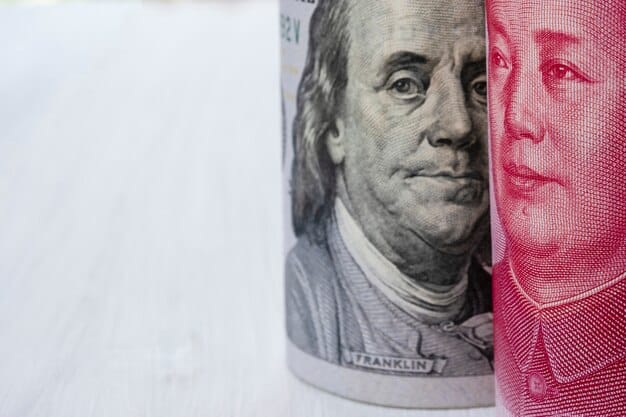Paid vs. Organic Search 2025: Prioritize Your Digital Strategy

Navigating the digital marketing landscape in 2025 requires a strategic understanding of whether to prioritize paid search, offering immediate visibility and granular control, or organic search, building sustainable, long-term authority and trust.
In the evolving digital marketing arena, a central question for businesses is: paid search vs. organic search: which strategy should you prioritize in 2025? This isn’t merely a tactical choice; it’s a foundational decision that shapes your online presence, budget allocation, and ultimately, your return on investment. As search engines become more sophisticated and user behavior continues to shift, understanding the nuanced differences and synergistic potential of these two powerful approaches is more critical than ever.
Understanding the Core Definitions: Paid vs. Organic Search
To effectively compare and contrast paid and organic search, it’s essential to first establish a clear understanding of what each entails. Both are fundamental components of a comprehensive search engine marketing (SEM) strategy, yet they operate on distinct principles and deliver different types of value. Delving into their core mechanics helps lay the groundwork for strategic decision-making in 2025.
What is Paid Search (PPC)?
Paid search, often referred to as Pay-Per-Click (PPC) advertising, involves bidding on keywords to display ads at the top or bottom of search engine results pages (SERPs). When a user clicks on an ad, the advertiser pays a fee to the search engine. This model offers immediate visibility, precise targeting capabilities, and measurable results, making it an attractive option for rapid market penetration or specific campaign objectives.
- Instant Visibility: Ads appear quickly, often within minutes of campaign launch.
- Targeted Audience: Campaigns can be highly segmented by demographics, location, interests, and past behavior.
- Budget Control: Advertisers set daily or monthly budgets, controlling ad spend.
- Measurable ROI: Detailed analytics provide insights into ad performance, click-through rates, and conversions.
The beauty of paid search lies in its agility. You can react quickly to market changes, test new products, or capitalize on seasonal trends. However, this immediacy comes at a cost, as visibility stops the moment your budget runs out. Sustained presence requires continuous investment.
What is Organic Search (SEO)?
Organic search, on the other hand, centers around Search Engine Optimization (SEO). This discipline focuses on improving a website’s ranking in unpaid search results through various on-page and off-page optimization techniques. The goal is to make your content as relevant and authoritative as possible for specific keywords, thereby earning high rankings that drive free, sustainable traffic over time. This approach builds long-term equity and trust with your audience.
- Long-Term Value: Rankings, once achieved, can persist for extended periods.
- Cost-Effective over time: No direct cost per click, making it highly efficient.
- Increased Trust: Users often perceive organic results as more credible and authoritative.
- Brand Authority: High organic rankings establish your brand as an expert in its field.
SEO is a marathon, not a sprint. It typically takes months to see significant results, as search engines evaluate numerous factors, including content quality, website structure, backlinks, and user experience. Patience and consistent effort are paramount, but the sustained, compounding benefits often outweigh the initial time investment.
From these foundational definitions, it becomes clear that while both strategies aim to connect users with relevant information, their underlying mechanisms, timelines, and cost structures are vastly different. Understanding these distinctions is the first step toward crafting a balanced and effective digital marketing strategy for the year ahead.
The Advantages of Prioritizing Paid Search in 2025
In many scenarios, prioritizing paid search offers distinct advantages, particularly for businesses seeking rapid results, precise targeting, or short-term campaign success. As we move into 2025, the capabilities of advertising platforms continue to evolve, granting advertisers unparalleled control and insights. This section explores the key benefits of leaning into paid search as a primary strategy.
Immediate Visibility and Rapid Results
One of the most compelling reasons to prioritize paid search is its ability to deliver immediate visibility. Unlike organic efforts that can take months to yield results, a well-structured PPC campaign can place your ad at the top of SERPs within hours of launch. This

instant exposure is invaluable for:
- New Product Launches: Quickly introduce new offerings to a target market.
- Short-Term Promotions: Drive traffic and sales during seasonal events or limited-time offers.
- Brand Awareness: Gain significant exposure for a new or established brand looking for immediate reach.
This speed allows businesses to capitalize on trending topics, immediate market needs, or competitive shifts without waiting for search engines to index and rank their content organically. The rapid feedback loop also enables quick optimization.
Precise Targeting and Audience Reach
Paid search platforms offer incredible granularity when it comes to audience targeting. Advertisers can define their audience based on an extensive array of parameters:
- Demographics: Age, gender, income, parental status.
- Geographic Location: Specific countries, states, cities, or even radii around physical addresses.
- Interests and Behaviors: Based on browsing history, past purchases, or affinity categories.
- Remarketing: Re-engaging users who have previously interacted with your website or app.
This precision ensures that your ad spend is directed towards the most relevant potential customers, minimizing wasted impressions and maximizing the likelihood of conversions. The ability to tailor messages to specific audience segments significantly improves campaign effectiveness and ROI.
Measurable ROI and Budget Control
The highly measurable nature of paid search is another significant advantage. Every click, impression, and conversion can be tracked, providing advertisers with rich data to analyze campaign performance. This transparency allows for:
- Real-time Optimization: Adjust bids, keywords, ad copy, and landing pages to improve results on the fly.
- Clear ROI Calculation: Directly link ad spend to revenue generated, enabling precise return on investment calculations.
- Flexible Budgeting: Set daily limits, pause campaigns, or adjust spending based on performance or seasonality.
This level of control ensures that businesses can optimize their campaigns for maximum efficiency, making paid search a predictable and scalable channel for growth when managed effectively. For businesses that need to hit specific sales targets quickly or test market demand for new offerings, paid search provides the tools for rapid deployment and detailed performance analysis.
The Advantages of Prioritizing Organic Search in 2025
While paid search offers immediate gratification, organic search builds a sustainable, long-term presence that can yield compounding returns over time. Prioritizing SEO in 2025 involves investing in practices that enhance your website’s authority, trustworthiness, and relevance in the eyes of search engines and users alike. The benefits of a strong organic strategy extend far beyond simple traffic acquisition.
Building Long-Term Authority and Trust
One of the greatest advantages of organic search is its ability to foster genuine authority and trust. When your website consistently ranks high for relevant keywords, it signals to users that you are a credible and knowledgeable source. This perception of trustworthiness translates into higher click-through rates and improved engagement. Users often bypass ads, seeking the “authentic” results provided by organic listings.
A robust organic presence:
- Enhances Brand Credibility: High rankings suggest expertise and reliability.
- Generates Sustained Traffic: Once achieved, top organic rankings can drive consistent, highly qualified traffic for extended periods without ongoing per-click costs.
- Fosters User Loyalty: Trust built through organic presence often leads to repeat visits and stronger customer relationships.
This long-term equity is something paid search cannot fully replicate. It’s about establishing your brand as a foundational pillar in your industry, not just a temporary presence.
Cost-Effectiveness Over Time
While SEO requires an initial investment in time, resources, and expertise, it becomes significantly more cost-effective than paid search in the long run. Once your content consistently ranks well, you no longer pay for each click. This “free” traffic can lead to substantial savings compared to the perpetual budget required for PPC campaigns. Consider the cumulative value of organic traffic:
- Reduced Ad Spend: Less reliance on paid channels for core traffic.
- Compounding Returns: Early SEO efforts continue to pay dividends years down the line.
- Higher ROI Potential: The cumulative value of free traffic often outweighs the initial investment.
For established businesses seeking sustainable growth and reduced marketing overhead, SEO represents a strategic investment that pays dividends well into the future, creating a valuable digital asset in your website’s organic visibility.
Improved User Experience and Website Health
Modern SEO is inextricably linked to providing an excellent user experience. Search engines like Google prioritize websites that are fast, mobile-friendly, easy to navigate, and offer high-quality, relevant content. By focusing on SEO best practices, you naturally improve your website’s overall health and usability:
- Faster Page Load Times: Reduces bounce rates and improves user satisfaction.
- Mobile Responsiveness: Ensures a seamless experience across all devices.
- Structured Content: Makes information easier to find and digest.
- Enhanced Accessibility: Broadens your audience reach.
A website optimized for search engines is inherently optimized for users. This holistic approach not only helps you rank higher but also leads to better engagement, longer dwell times, and ultimately, higher conversion rates. By prioritizing organic search, you are essentially investing in the fundamental quality and utility of your digital storefront.
Synergistic Strategies: How Paid and Organic Search Can Work Together
While often discussed as competing strategies, paid and organic search are most powerful when integrated into a cohesive digital marketing plan. Leveraging the strengths of one to bolster the other can lead to a more robust, efficient, and higher-performing overall strategy. In 2025, a truly advanced digital marketing approach views these two channels not as alternatives, but as complementary forces.
Filling the Gaps with Paid Search
Paid search can serve as an agile complement to organic efforts, especially during the initial stages of a website or for highly competitive keywords where organic ranking is challenging. Consider these synergistic uses:
- New Keyword Testing: Use PPC to quickly test the conversion potential of new keywords before investing in long-term SEO content creation. If a keyword converts well via paid ads, it’s a strong candidate for organic optimization.
- Covering Organic Weaknesses: If your organic ranking is low for a critical keyword, paid ads can provide immediate visibility while your SEO efforts catch up. This ensures you capture traffic that you would otherwise miss.
- Seasonal or Timely Campaigns: For promotions or events with a limited shelf life, paid search can generate immediate traffic and conversions, complementing any SEO efforts for evergreen content.
PPC acts as a valuable safety net and testing ground, allowing you to secure traffic and data while waiting for organic strategies to mature. It ensures you maintain market presence even when your organic rankings face stiff competition or are still developing.
Amplifying Organic Success with Paid Strategy
Conversely, a strong organic presence can significantly enhance the effectiveness of paid search campaigns. When your brand consistently appears in both organic and paid results for the same keywords, it creates a powerful “double-dip” effect, increasing your visibility and perceived authority. This is often referred to as SERP dominance.
- Increased Click-Through Rates: Studies show that appearing in both paid and organic results can increase overall clicks by a significant margin, as users are more likely to trust a brand that occupies multiple positions.
- Reduced CPC for Branded Terms: If your brand ranks organically for its own name, running paid ads for branded terms often becomes cheaper. The high relevance and quality score associated with your organic presence can positively influence your ad quality score, leading to lower costs per click.
- Targeting Complementary Keywords: Use paid search to target commercial-intent keywords while your organic strategy focuses on informational keywords higher up the funnel. This ensures you capture users at every stage of their buyer journey.
By coordinating your efforts, you can build a formidable online presence that maximizes both immediate conversions and long-term brand equity. The synergy between paid and organic search allows for a more comprehensive and resilient digital marketing framework, adapting to market dynamics while building lasting value.
Factors to Consider When Prioritizing Your Strategy in 2025
Deciding whether to prioritize paid or organic search in 2025 isn’t a one-size-fits-all answer. It depends heavily on various factors unique to your business, industry, and marketing objectives. A careful evaluation of these elements will guide you toward the most effective allocation of your time, resources, and budget.
Industry Competition and Keyword Landscape
The level of competition within your industry and for specific keywords plays a crucial role. In highly saturated markets with fierce competition for top organic rankings, paid search might offer a more immediate and predictable path to visibility. Conversely, in niche markets with less competition, organic efforts might yield faster and more cost-effective results. Researching keyword difficulty and cost-per-click rates will provide valuable insights into the viability of each channel.
Budget and Resources
Your available budget and internal resources are significant determinants. Paid search requires a direct advertising spend, whereas SEO demands investment in content creation, technical optimization, and often, specialized expertise. While SEO can be “free” per click, the initial setup and ongoing maintenance require substantial time and effort. Small businesses with limited resources might initially lean on more accessible, targeted paid campaigns, while larger enterprises might have the capacity for sustained, long-term SEO investments.
Business Goals and Timeline
What are your primary business objectives, and what is your desired timeline for achieving them?

If you need immediate leads, rapid sales, or quick brand exposure, paid search is likely the preferred option. If your goal is to build long-term brand authority, establish thought leadership, and generate sustainable, compounding traffic, then organic search should be a central focus. Aligning your marketing strategy with your overarching business goals is paramount.
Market Maturity and Audience Behavior
Consider the maturity of your market and how your target audience typically interacts with search results. In industries where users are highly sensitive to advertising or prefer independent research, organic rankings might hold more sway. For new products or services where immediate education and awareness are key, paid ads can be effective. Understanding your audience’s digital behavior will inform which channel is more likely to capture their attention and trust.
Existing Digital Presence and Website Health
If you have an established website with a good domain authority and some existing organic rankings, building upon that foundation with further SEO efforts might be more efficient. However, if you are launching a brand new website with no existing authority, paid search can provide the necessary initial traction while your SEO efforts take root. A healthy, well-optimized website is a prerequisite for both successful paid and organic strategies, but its current state will influence your strategic prioritization.
By thoroughly assessing these factors, businesses can make informed decisions about how to best allocate their resources and which strategy—or combination of strategies—will most effectively meet their unique objectives in the competitive digital landscape of 2025. It’s not about choosing one over the other definitively, but rather selecting the optimal mix for your specific circumstances.
Measuring Success: KPIs for Both Strategies
Regardless of whether you prioritize paid or organic search, or a combination of both, the ability to effectively measure success is critical. Key Performance Indicators (KPIs) provide the necessary metrics to track progress, identify areas for improvement, and ultimately demonstrate the return on your marketing investment. Understanding which KPIs matter most for each strategy ensures you’re looking at the right data to guide your decisions in 2025.
Key Performance Indicators for Paid Search (PPC)
Paid search campaigns offer a wealth of granular data, allowing for precise measurement and optimization. The primary goal is to maximize conversions while minimizing cost. Essential PPC KPIs include:
- Cost Per Click (CPC): The average amount you pay for each click on your ad. Lower CPC indicates more efficient ad spend.
- Click-Through Rate (CTR): The percentage of impressions that result in a click. A higher CTR indicates relevant ad copy and targeting.
- Conversion Rate (CVR): The percentage of clicks that result in a desired action (e.g., a purchase, form submission, download). This is often the most critical metric for ROI.
- Cost Per Acquisition (CPA): The total cost of advertising divided by the number of conversions. This tells you how much it costs to acquire a new customer or lead.
- Return on Ad Spend (ROAS): The revenue generated for every dollar spent on advertising. This is a direct measure of profitability.
- Impression Share: The percentage of available impressions your ads received compared to the total number of impressions they could have received. This indicates market presence.
By regularly monitoring these metrics, advertisers can quickly identify underperforming elements, adjust bids, refine targeting, and optimize ad copy to improve campaign efficiency and profitability.
Key Performance Indicators for Organic Search (SEO)
SEO success is measured over a longer horizon and focuses on traffic quality, visibility, and authority. While direct revenue attribution can be more complex than with PPC, the long-term benefits are substantial. Key SEO KPIs include:
- Organic Traffic: The number of visitors coming to your site from organic search results. This indicates the overall effectiveness of your SEO efforts.
- Keyword Rankings: Your website’s position in SERPs for target keywords. Higher rankings correlate with increased visibility.
- Bounce Rate: The percentage of visitors who leave your site after viewing only one page. A high bounce rate might indicate irrelevant content or poor user experience.
- Time on Page / Engagement: How long users stay on your pages and how they interact with your content. Longer times suggest valuable content.
- Backlinks: The number and quality of links from other websites to yours. Backlinks are a significant factor in search engine authority.
- Domain Authority (DA) / Domain Rating (DR): Metrics (from third-party tools) that estimate the overall strength and authority of your domain.
- Organic Conversion Rate: The percentage of organic visitors who complete a desired action. This links SEO efforts directly to business goals.
Tracking these KPIs helps in understanding the impact of content strategies, technical SEO improvements, and link-building efforts. Consistent monitoring allows for iterative improvements and ensures your organic presence continues to grow and deliver value. A holistic view, integrating both paid and organic KPIs, provides the clearest picture of your overall digital marketing performance.
The Future of Search: What to Expect in 2025 and Beyond
The digital marketing landscape is perpetually in motion, and 2025 promises further evolution in search algorithms and user behavior. Anticipating these shifts is crucial for any business formulating its long-term strategy. Understanding the future trajectories of both paid and organic search will help decision-makers remain agile and competitive.
Evolving Search Algorithms and User Intent
Search engines are becoming incredibly sophisticated at understanding user intent behind queries. This means that keyword matching alone is no longer sufficient; context, semantic understanding, and the nuance of natural language are increasingly important. For organic search, this reinforces the need for:
- Comprehensive Content: Creating in-depth, authoritative content that fully answers user questions and anticipates follow-up queries.
- AI-Driven Content Creation and Optimization: Leveraging AI tools to identify content gaps, optimize for semantic search, and personalize user experiences.
- Focus on E-E-A-T: Google’s emphasis on Experience, Expertise, Authoritativeness, and Trustworthiness will only grow, demanding content creators to demonstrate real-world credibility.
Paid search will also benefit from advanced AI in targeting and bidding, allowing for even more precise ad delivery and automated optimization, moving beyond manual campaign management.
The Rise of AI in Search and Advertising
Artificial intelligence is already reshaping search and advertising, and its influence will only deepen by 2025. AI-powered tools are improving every facet of digital marketing:
- Generative AI for Content: While AI won’t replace human creativity, it will become an invaluable assistant for generating outlines, drafting content, and repurposing existing material for SEO.
- Automated Bidding in PPC: AI algorithms will continue to optimize bids and budgets in real-time, making PPC campaigns more efficient and effective, often outperforming manual management.
- Personalized Search Experiences: Search results will become even more tailored to individual user histories, preferences, and locations, making a generalized “top ranking” less impactful than a highly relevant one.
Embracing AI as a tool, rather than fearing it, will be a key differentiator for businesses in 2025. It will free up marketers to focus on higher-level strategy and creative differentiation.
The Blurring Lines Between Organic and Paid
As search engines integrate more features into SERPs—such as rich snippets, featured snippets, knowledge panels, and enhanced shopping results—the distinction between traditional organic listings and paid ads will continue to blur. This “SERP dominance” strategy, where businesses aim to occupy as much screen real estate as possible, will become increasingly vital. This means:
- Integrated Reporting: Marketers will demand unified dashboards that show performance across all search touchpoints, rather than siloed reports for SEO and PPC.
- Holistic Conversion Paths: The user journey rarely fits neatly into “organic only” or “paid only.” Strategies will need to account for users interacting with both types of results before converting.
- Voice Search Optimization: As voice search grows, both paid and organic strategies will need to adapt to conversational queries and the unique ways in which voice technology delivers results.
In 2025, the most successful digital marketers will be those who adopt a panoramic view of search, understanding that paid and organic are two sides of the same powerful coin. The goal will be to create a seamless, ubiquitous brand presence that captures attention and drives conversions across all evolving search touchpoints.
| Key Aspect | Brief Description |
|---|---|
| 🚀 Speed to Results | Paid search offers immediate visibility; organic builds over time. |
| 💰 Cost Structure | PPC has direct per-click costs; SEO is cost-effective long-term. |
| 🎯 Control & Targeting | Paid offers precise targeting; organic relies on relevance and authority. |
| 🤝 Trust & Authority | Organic builds credibility; paid delivers quick, controlled exposure. |
Frequently Asked Questions About Search Prioritization
▼
Yes, significant results can be achieved solely through organic search. Many businesses thrive on organic traffic alone, especially those with strong content strategies and long-term SEO investments. However, in highly competitive markets or for immediate impact, supplementing with paid search can accelerate growth and cover gaps while organic efforts mature.
▼
Paid search delivers results almost immediately; ads can be live and generating clicks within hours or days. Organic search, on the other hand, typically takes several months to see meaningful results, often 3-6 months or more, as search engines need time to crawl, index, and rank your content effectively based on numerous factors.
▼
In the long run, organic search often becomes more cost-effective. While it requires an upfront investment in content and optimization, the traffic generated has no per-click cost. Paid search requires continuous spending, and costs can escalate in competitive markets. However, paid search offers predictable costs per conversion and immediate ROI.
▼
For small businesses, a balanced approach is often best. If immediate leads or sales are critical, paid search can provide quick wins. Concurrently, implementing basic SEO practices and focusing on niche content can lay the groundwork for long-term organic growth. The best starting point depends on budget, industry, and immediate goals.
▼
AI will increasingly influence both. For organic, AI helps in understanding complex user intent and optimizing content for semantic search. For paid, AI powers highly efficient automated bidding, targeting, and ad creation, further enhancing campaign performance. Businesses leveraging AI tools effectively will gain a significant competitive edge in both domains.
Conclusion
In the dynamic landscape of 2025, the question of whether to prioritize paid search or organic search is not about choosing one over the other in absolute terms. Instead, it’s about understanding their unique strengths and how they can synergistically propel your digital marketing efforts forward. Paid search offers unparalleled speed, precise targeting, and immediate, measurable results, making it ideal for rapid campaigns and market testing. Organic search, conversely, builds long-term authority, fosters trust, and provides a sustainable, cost-effective source of high-quality traffic. The most robust digital strategies for the coming years will likely integrate both, using paid to fill gaps and accelerate growth, while simultaneously investing in organic to build enduring brand equity and a resilient online presence. By carefully evaluating your specific business goals, budget, industry competition, and anticipating future trends like the increasing influence of AI, you can craft a strategic balance that maximizes your visibility, conversions, and overall return on investment.





